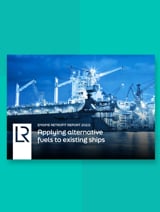Note: Blue methanol, made using natural gas, does not meet our definition of a zero carbon fuel and, for this reason, is not considered on this page.
Compare readiness levels
The graphs below provide information on methanol fuels and their readiness levels. You can view the combined fuels and readiness levels or select them individually by clicking on the coloured labels and filters.
Exploring the advantages of methanol as a marine fuel
- Sulphur oxide emissions: No sulphur oxides and very low levels of particulate matter are emitted from methanol combustion.
- Storage requirements: Methanol is a liquid at ambient temperatures and pressures and therefore does not need to be pressurised, compressed or stored cryogenically.
- Miscible in water: methanol is highly soluble, so in the event of a spill, the fuel will rapidly dissolve in seawater.
- Acceptable energy density: The energy density of methanol is broadly similar to ammonia and higher than hydrogen, making onboard storage economically feasible, albeit not as compact as the heavy fuel oil (HFO) used today.
Risks and disadvantages
- Carbon dioxide emissions: Tank to wake emissions are only marginally lower than fossil fuels, however it is considered that these can be offset through carbon negative supply chain.
- Safety considerations: methanol is highly toxic, flammable and corrosive, so stringent safety measures and appropriately constructed and coated storage tanks are required.
Differences between methanol fuels
| Biomethanol (ligno) |
Biomethanol is produced from lignocellulosic feedstocks (biomass) such as agricultural waste and by-products. The biomass undergoes a gasification or reformation process to produce syngas, which is a mixture of carbon monoxide and hydrogen gas. The syngas is cleaned to remove impurities and then subjected to methanol synthesis. This involves a catalytic reaction where the carbon monoxide and hydrogen gas react to form methanol.
|
| E-methanol (with DAC) |
E-methanol is produced from carbon dioxide (extracted from ambient air using direct air capture (DAC) and e-hydrogen. E-hydrogen gas is produced using renewable energy to separate the hydrogen from water through electrolysis. The carbon dioxide and hydrogen gas are then combined through methanol synthesis, which is a catalytic reaction, to form methanol.
|
Methanol readiness insights
Resources |
||||
| Fuel Type | Rating | Description | Justification | Challenge |
| Biomethanol | 7 | Low scale pilot production demonstrated | First marine pilots have been demonstrated but scale up is required to meet shipping demand | Supply at scale of sustainable biomass feedstock for shipping needs to be demonstrated |
| E-methanol (with DAC) | 7 | Low scale pilot production demonstrated | First marine pilots have been demonstrated but scale up is required to meet shipping demand | A scaled up supply chain and workforce needs to be established for the supply of renewable electricity as well as sustainable carbon sourcing for e-methanol production for shipping |
Production |
||||
| Fuel Type | Rating | Description | Justification | Challenge |
| Biomethanol | 3 | First assessment feasibility concept and technologies | Production is validated but still at small scale | The production process needs to be optimised to achieve a cost-effective way to scale up production, as well as resource supply at scale |
| E-methanol (with DAC) | 4 | Validation of integrated prototype in test environment | DAC facilities for sustainable carbon sourcing are at prototype stage. Electrolysis for production of e-hydrogen is proven but needs to be scaled. | Electrolysis and direct air capture facilities need to be industrialised at scale. |
Bunkering and ports |
||||
| Fuel Type | Rating | Description | Justification | Challenge |
| Biomethanol | 6 | Pre-production product | Storage and bunkering procedures at ports are in place, and bunkering has been successfully demonstrated | Scale-up of bunkering in more locations and environments is needed |
| E-methanol (with DAC) | ||||
Ship - Onboard handling and storage |
||||
| Fuel Type | Rating | Description | Justification | Challenge |
| Biomethanol | 8 | Manufacturing fully tested, validated and qualified | Materials and components for methanol storage are well understood, and widely used, though not yet not deployed across all ship types | The technology needs to be deployed across all ship types |
| E-methanol (with DAC) | ||||
Ship - Propulsion |
||||
| Fuel Type | Rating | Description | Justification | Challenge |
| Biomethanol | 8 | Manufacturing fully tested, validated and qualified | Engines have been successfully demonstrated | The technology needs to be deployed across all ship types |
| E-methanol (with DAC) | ||||
Resources |
||||
| Fuel Type | Rating | Description | Justification | Challenge |
| Biomethanol | 2 | Commercial trial, small scale | Early revenue projections have identified competitive target markets however commerical scaling depends on further development of resource supply chains | Signals need to be provided to investors that show a stable, attractive market, in order to stimulate scale-up of supply |
| E-methanol (with DAC) | 3 | Commercial scale up | Commercial supply chains are not developed into a competitive market | There is a need to reduce risks of investing in countries with low credit ratings because many of these countries are well suited to provide renewable resources and will therefore be required for scale up of supply. Additionally the sustainable sourcing of carbon needs to be proven economically viable. |
Production |
||||
| Fuel Type | Rating | Description | Justification | Challenge |
| Biomethanol | 3 | Commercial scale up | Offtake agreements are beginning to emerge, however commercial scaling depends on further development of resource supply chains | Resource supply at scale needs to be demonstrated, and production process needs to be optimised to achieve an economically viable way to scale up production |
| E-methanol (with DAC) | 3 | Commercial scale up | Green methanol production facilities are receiving public and private funding and are in the process of developing DAC and scaling green methanol production to match demand | Continued demand signals from shipping are needed to further increase investment in green methanol production facilities that will supply shipping |
Bunkering and ports |
||||
| Fuel Type | Rating | Description | Justification | Challenge |
| Biomethanol | 2 | Commercial trial, small scale | Bunkering has been successfully demonstrated, with more trials in planning stages due to demand signals of increasing retrofits and newbuild orders of methanol (dual fuel) ships | Stakeholders responsible for investing in bunkering and port infrastructure need to understand the demand profiles and infrastructure required for alternative fuels, including methanol, in order to unlock investment. |
| E-methanol (with DAC) | ||||
Ship |
||||
| Fuel Type | Rating | Description | Justification | Challenge |
| Biomethanol | 3 | Commercial scale up | Commercial trials are increasing and offtake agreements between shipowners and fuel suppliers are emerging | The competitiveness of methanol against alternative options needs to be proven in the mid-and long-term. Incentives to invest in methanol are needed from regulatory change |
| E-methanol (with DAC) | ||||
Resources |
||||
| Fuel Type | Rating | Description | Justification | Challenge |
| Biomethanol | 2 | Stakeholder support or opposition is becoming understood as a result of pilots | Resource and production have been proven, however regulatory framework for lifecycle assessment is insufficient | Global regulatory framework for lifecycle assessment requires further development and adoption to enable the use of biomass derived fuels, for example bringing the International Sustainability and Carbon Certification (ISCC) for biofuels in at IMO level |
| E-methanol (with DAC) | 4 | Evidence becoming wide-spread resulting in initial stakeholder acceptance | Small scale solutions show some acceptance at a local level, however scaling renewable electricity requires community acceptance around potential environmental and social impacts | Communities need educating on the wider benefits of renewable energy and to dedicate land use for these purposes. Additionally, carbon sourcing certification needs to be in place. |
Production |
||||
| Fuel Type | Rating | Description | Justification | Challenge |
| Biomethanol | 2 | Stakeholder support or opposition is becoming understood as a result of pilots | Resource and production have been proven, however regulatory framework for lifecycle assessment is insufficient | Global regulatory framework for lifecycle assessment requires further development and adoption to enable the use of biomass derived fuels, for example bringing the International Sustainability and Carbon Certification (ISCC) for biofuels in at IMO level |
| E-methanol (with DAC) | 3 | Early stage solution formation to tackle stakeholder issues | Scaling the technologies reduces community acceptance of environmental and social impacts | Communities need educating on the implications of using large scale wind farms, solar farms and DAC plants. Additionally, carbon sourcing certification needs to be in place. |
Bunkering and ports |
||||
| Fuel Type | Rating | Description | Justification | Challenge |
| Biomethanol | 2 | Stakeholder support or opposition is becoming understood as a result of pilots | Rules are in place for bunkering of methanol, however community concerns around emissions exist | Communities need be educated on the comparative analysis of other emissions and safety challenges |
| E-methanol (with DAC) | ||||
Ship |
||||
| Fuel Type | Rating | Description | Justification | Challenge |
| Biomethanol | 3 | Early stage solution formation to tackle stakeholder issues | Rules are in place for methanol-fuelled ships | Communities need to be educated on the comparative analysis (against alternative fuels) of other emissions affecting the crew |
| E-methanol (with DAC) | ||||
Back to: Methanol hub






